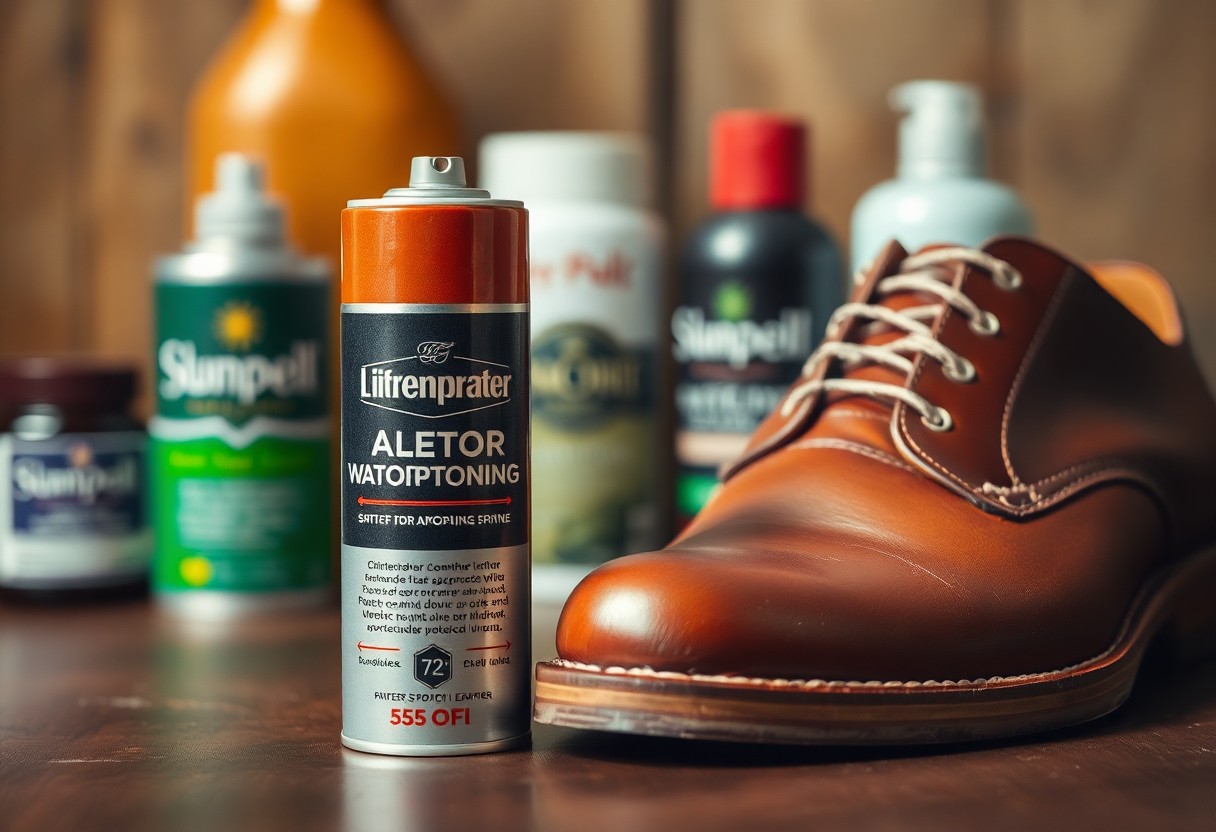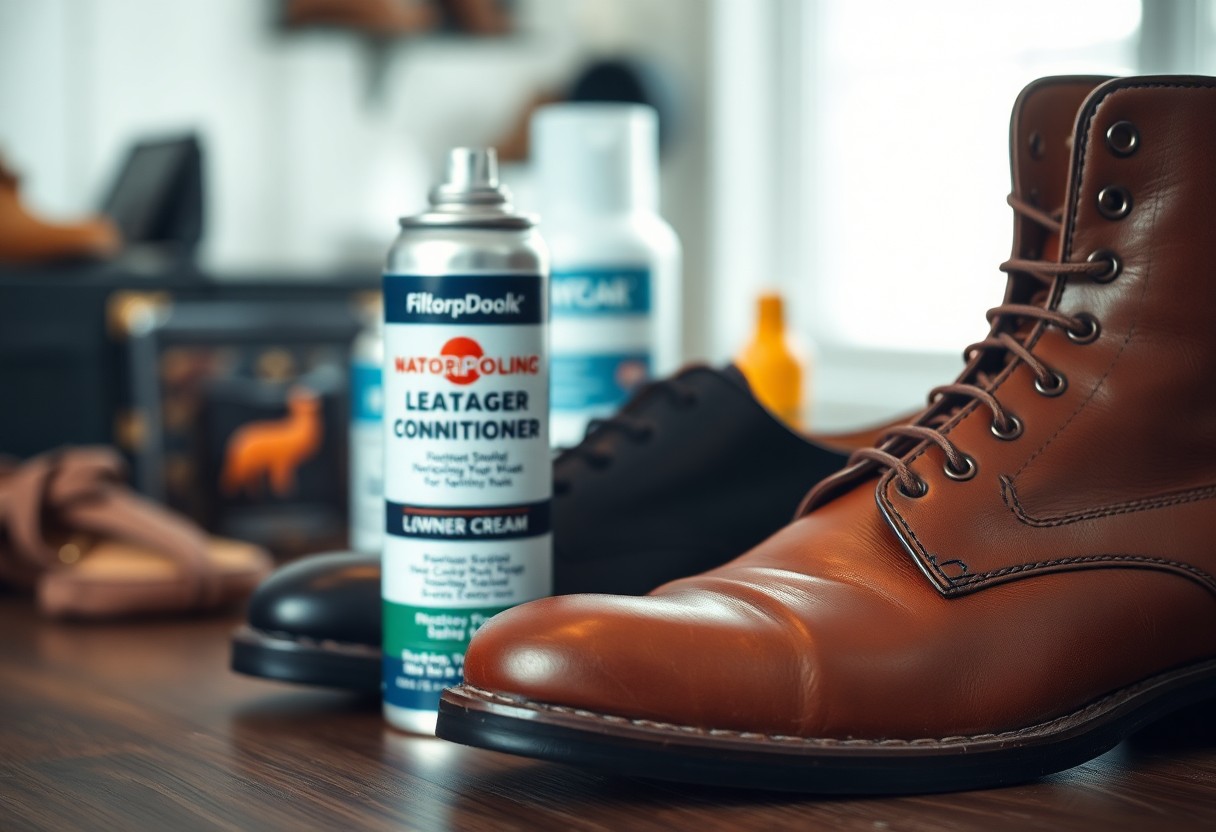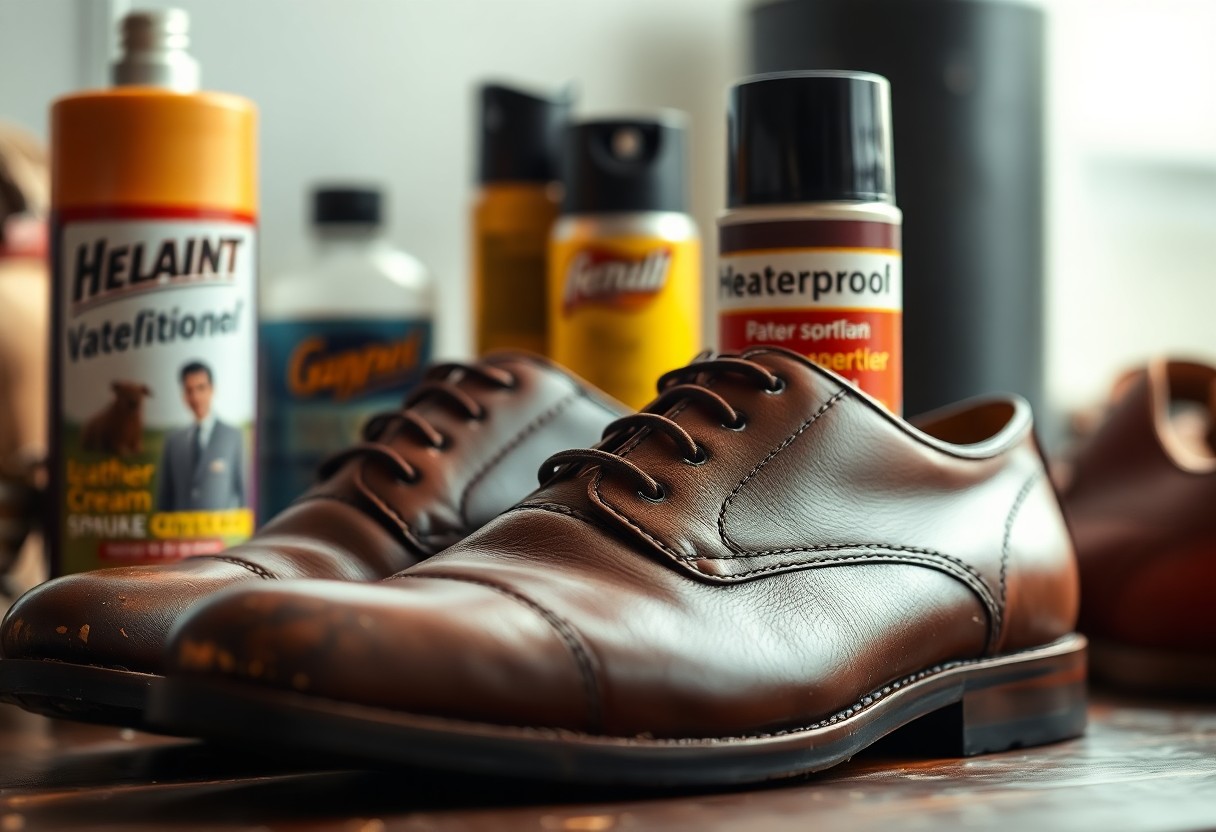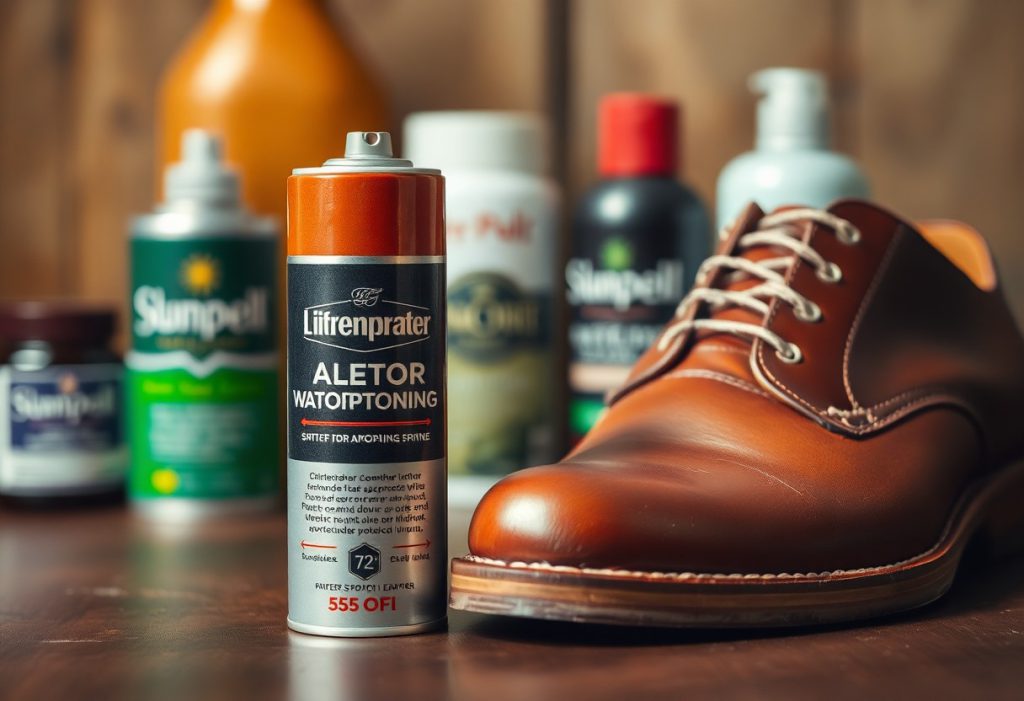Leather care mistakes can result in permanent damage to your valuable footwear. One of the most common blunders is applying waterproofing spray to smooth leather. While these sprays may seem like a simple solution for protecting your shoes, they can block essential nutrients from penetrating the leather, ultimately leading to dryness and cracking over time. Smooth leather shoes have inherent water-resistant properties that are part of their grain structure, requiring proper nourishment from shoe creams and waxes to maintain their longevity. Instead of resorting to sprays, choose high-quality leather conditioners and wax polishes that both protect and feed the leather, ensuring its durability while retaining its natural beauty.
Mastering the Fundamentals of Leather Protection Techniques
To extend the life of your leather goods, it’s essential to understand their protective characteristics. Full grain leather is endowed with natural water-resistant qualities due to its tightly knit fiber structure. However, these qualities necessitate consistent maintenance to remain effective. The longevity of your leather is profoundly influenced by the care it receives. Utilizing waterproofing sprays can compromise the leather’s ability to breathe, potentially leading to serious damage if not properly managed. By understanding the balance of protection and nourishment required, you can ensure your leather remains in optimal condition.
Uncovering the Unique Benefits of Full Grain Leather
After the tanning process is complete, full grain leather retains its original surface layer, offering remarkable natural protection. Items made from this material feature an intact grain layer that provides resistance against water and wear. This outer layer is rich in natural oils and fibers, forming a protective barrier that renders additional waterproofing sprays unnecessary and potentially harmful to the leather's well-being. Understanding these intrinsic qualities can guide you in making the best care decisions for your leather items.
Exploring Leather's Moisture Management and Aging Process
Grain leather must maintain its ability to absorb and release moisture effectively. The pores within the leather allow it to breathe and manage moisture, keeping it supple and preventing unsightly cracks. Unfortunately, waterproofing sprays can seal these pores, restricting vital airflow and disrupting the natural moisture equilibrium. Furthermore, as leather ages, it requires appropriate nourishment through conditioning products. When waterproofing sprays are used, they create a barrier that blocks essential conditioning oils from penetrating the leather, which can lead to dryness and brittleness over time. Regular application of leather cream enables your leather to age gracefully, developing a rich, appealing patina.

Recognizing the Dangers of Waterproofing Spray Misuse
Many people mistakenly believe that waterproofing spray is the ultimate safeguard for their leather shoes, but this widespread habit can cause serious harm to your footwear. Although these sprays provide an immediate shield against water, they simultaneously block critical nutrients from reaching the leather, paving the way for potential long-term degradation. Understanding this can help you make informed choices about the care of your leather goods.
Dispelling Common Myths About Leather Care Marketing Tactics
Influenced by aggressive marketing strategies and well-meaning advice from retail staff, you may have been led to believe that waterproofing spray is necessary for all leather shoes. This misconception has been perpetuated by many shoe retailers, primarily due to the high profit margins and frequent repurchase rates linked to these products. In reality, regular smooth leather has natural protective qualities that do not necessitate additional spray-on barriers for effective safeguarding. Recognizing the truth can lead to better care practices for your footwear.
Weighing Short-term Gains Against Long-term Leather Health
The damage to your leather shoes begins when waterproofing sprays form a barrier that prevents essential oils and conditioning agents from saturating the leather. Initially, you might observe improved water resistance, but your leather will gradually become dry and brittle without the necessary nourishment it needs. The consequences of using waterproofing sprays on smooth leather extend far beyond surface-level protection. Your leather needs consistent nourishment to maintain its flexibility and durability. When shoe creams and conditioners cannot penetrate the leather due to the spray barrier, the material risks cracking and deterioration, significantly reducing your shoes’ lifespan. Utilizing natural waxes and proper conditioning techniques offers superior long-term protection while nurturing the leather’s health.

Diving Into the Science Behind Effective Leather Care
A key component of successful leather care is understanding its molecular structure. The collagen fiber networks in your leather shoes require both protection and nourishment. When applying products to leather, they can either coat these fibers or penetrate deeply. This interaction is vital for the long-term health of your leather shoes, ensuring they remain supple and resist wear over time.
Highlighting the Necessity of Nourishing Leather Regularly
It is crucial to recognize that your leather shoes need regular nourishment to maintain their quality. The natural oils within your leather shoes help prevent cracking and ensure flexibility. Over time, these oils diminish due to regular wear and exposure to the elements. To safeguard the leather’s structural integrity, it’s essential to replenish these oils through consistent conditioning.
Examining the Barrier Effects Created by Waterproofing Sprays
A significant issue with waterproofing sprays is their propensity to form a barrier. When applied to smooth leather, these sprays create an impermeable layer that obstructs both water and essential nutrients. This barrier inhibits your leather care products from effectively penetrating the surface, resulting in a gradual decline in the quality of the leather over time. Understanding this barrier effect is crucial for maintaining your leather items.
The barrier created by waterproofing sprays can lead to a troubling cycle for your footwear. While these sprays successfully block water, they simultaneously prevent the absorption of conditioning products that are critical for sustaining the leather's health. Consequently, the leather may seem protected on the outside but is, in fact, dehydrating and becoming brittle internally. Silicone-based sprays are especially damaging, forming a permanent barrier that is difficult to remove without causing harm to the leather.
Implementing Proven Methods for Effective Leather Protection
Contrary to common beliefs, your smooth leather shoes require specific care methods that align with the natural properties of full-grain leather. The most effective approach combines traditional techniques with products designed to enhance the leather’s inherent protective qualities, ensuring both immediate protection and long-lasting durability for your footwear.
Reaping the Benefits of High-Quality Wax-based Solutions
An excellent alternative to waterproofing sprays is premium wax-based products. These solutions work harmoniously with your leather’s natural grain rather than working against it. When you apply wax polish, it forms a protective barrier that still allows the leather to breathe, making it particularly beneficial for toe caps and areas subjected to high wear. Choosing the right products can significantly enhance the longevity and appearance of your shoes.
Maximizing the Advantages of Cream and Conditioner Applications
Unlike conventional spray treatments, leather creams and conditioners provide essential nourishment while preserving the leather’s natural protective qualities. Your shoes benefit from oils that penetrate deeply into the material, helping to prevent dryness and cracking. Moreover, regular application of cream and conditioner creates a cumulative effect that enhances the quality of the leather over time. The natural oils in these products support the leather’s flexibility and strength, allowing it to develop a beautiful patina. It’s recommended to apply these products every 4-6 wears to maintain optimal leather condition and appearance.

Identifying When to Use Waterproofing Spray for Other Materials
Unlike smooth leather, certain materials greatly benefit from waterproofing sprays. These products create an effective water-resistant barrier on specific materials that lack inherent protection. Waterproofing sprays are particularly advantageous for suede, nubuck, and various textiles, where the material structure does not naturally resist moisture.
Enhancing Suede and Nubuck Footwear with Waterproofing Spray
When you treat your suede or nubuck shoes with waterproofing spray, you significantly enhance their resistance to moisture damage. Although many modern suede materials are pre-treated with factory waterproofing, applying additional protection can help maintain their defenses over time. The spray creates a protective barrier that effectively prevents water from penetrating these delicate materials, safeguarding their appearance and quality.
Providing Essential Protection for Textile Footwear
In addition to leather alternatives, textile footwear requires specialized protection to guard against water damage. Materials like canvas, mesh, and synthetic fabrics can achieve enhanced water resistance through proper spray applications. Most textile materials are naturally absorbent, rendering them vulnerable to water damage and staining.
Furthermore, waterproofing sprays for textiles help maintain the shape and color of your shoes. The barrier they create also prevents dirt and debris from embedding into the fabric fibers. For optimal protection, it’s advisable to reapply the spray every 3-4 months, depending on usage and prevailing weather conditions.
Insights from Leather Care Professionals on Best Practices
Not all leather treatments are created equal. Experts in leather care strongly recommend avoiding waterproofing sprays on smooth leather. Your full-grain leather shoes require specialized care that allows them to breathe and absorb nourishing treatments. Using inappropriate products can lead to leather damage costing hundreds of dollars, making it crucial to choose your maintenance products wisely.
Expert Insights from Tannery Specialists
To maintain the quality of leather, tannery specialists assert that full-grain leather inherently has natural water-resistant properties within its outer layer. To sustain these protective qualities, it is essential to apply oils and waxes. Waterproofing sprays can obstruct these vital treatments from reaching the leather, leading to deterioration over time.
Guidance from Professional Cobblers on Leather Care
For the long-term upkeep of leather, professional cobblers advocate for the use of wax-based products rather than waterproofing sprays. Your shoes will thrive with treatments that both protect and nourish the leather. Research indicates that 90% of premature leather damage arises from using incorrect care products, underscoring the importance of proper maintenance techniques.
By adhering to effective leather care practices, your shoes can last an impressive 15-20 years instead of just 2-3 years with inadequate maintenance. Traditional wax treatments allow leather to retain its natural properties while providing necessary moisture protection. Your investment in quality leather footwear deserves meticulous care routines that preserve both its aesthetic appeal and durability.
Essential Takeaways for Optimal Leather Care Practices
To summarize, your smooth leather shoes necessitate appropriate care that excludes waterproofing sprays. Instead, opt for shoe creams and waxes that nourish the leather while providing effective water protection. Full-grain leather naturally possesses protective qualities, and waterproofing sprays may hinder essential oils from penetrating the leather, resulting in dryness and cracking. Reserve waterproofing sprays for suede, nubuck, or textile footwear where they can be effective. By selecting the right products, you can protect your leather shoes while ensuring their longevity and visual appeal.
Your Top Questions About Leather Care Answered
Q: What makes waterproofing spray harmful to smooth leather shoes?
A: Waterproofing spray creates a barrier on the leather that blocks essential oils and conditioners from penetrating the material. While it does provide water protection, it hampers the necessary nourishment of the leather, leading to drying and potential cracking over time, ultimately shortening the lifespan of the shoes.
Q: What alternatives should I use instead of waterproofing spray on smooth leather shoes?
A: Consider using a combination of shoe cream and wax polish instead. Shoe cream supplies essential oils to nourish the leather, while wax polish forms a protective layer that helps repel water. This method aligns well with the natural protective properties of full-grain leather, maintaining the health of the leather while providing effective water resistance.
Q: Which types of footwear can I safely apply waterproofing spray to?
A: Waterproofing spray is suitable for materials such as suede, nubuck, and textiles. These materials lack the natural protection found in smooth leather, thus benefiting from the protective barrier created by waterproofing sprays. Many modern suedes and nubucks may already have factory waterproofing treatments, but additional spray applications can enhance and sustain this level of protection.
The Article Why you shouldn’t use waterproofing spray on regular smooth leather and better alternatives appeared first on My Shoes Finder
The Article Waterproofing Spray on Smooth Leather: Risks and Alternatives Was Found On https://limitsofstrategy.com



Ah, the classic waterproofing spray blunder—like putting a raincoat on a fish! It’s amusing (and a bit tragic) how we often seek the quick fix without considering the long-term effects. I remember when I first got my beloved pair of smooth leather boots; I was convinced that a spritz of waterproofing wonder would be my saving grace during a surprise rainstorm. Fast forward a few months, and my poor boots were beginning to resemble the cracked surface of the moon. Lesson learned: it’s all about nourishment.
I really appreciate how you broke down the common leather care mistakes—it’s so easy to overlook the specifics! I’ve definitely made the mistake of using waterproofing spray on my leather shoes in the past, thinking I was doing them a favor. It wasn’t until I noticed the leather looking dull and feeling stiff that I realized the impact. Your point about how smooth leather has its own water-resistant properties really hit home for me.
I completely understand where you’re coming from. It’s easy to assume that any product marketed as protective is good for leather, but it can really do more harm than good. I’ve had similar experiences with my leather jackets; I once thought a heavy-duty waterproofing spray would keep it looking pristine. Instead, it ended up feeling stiff and kind of lifeless.